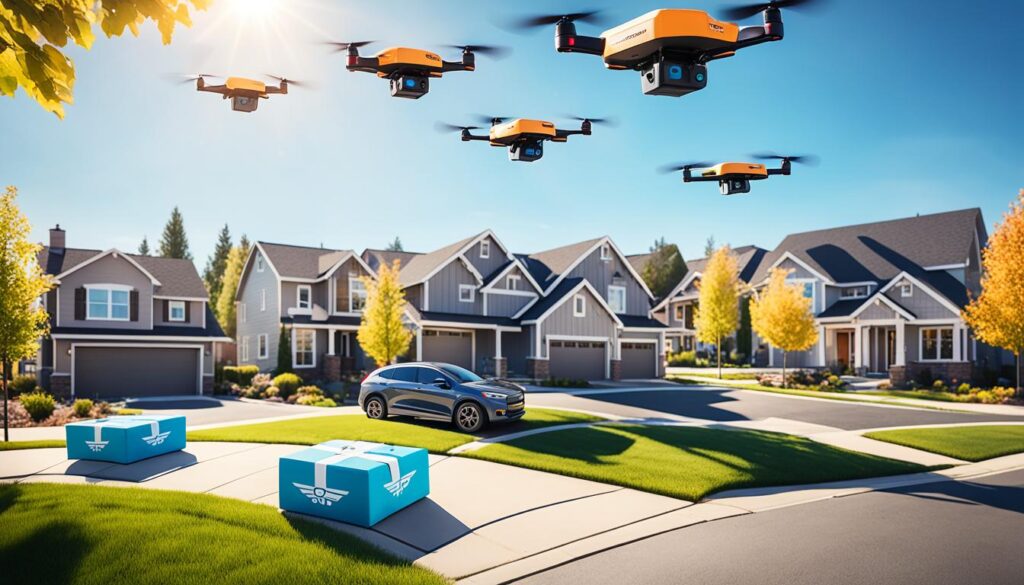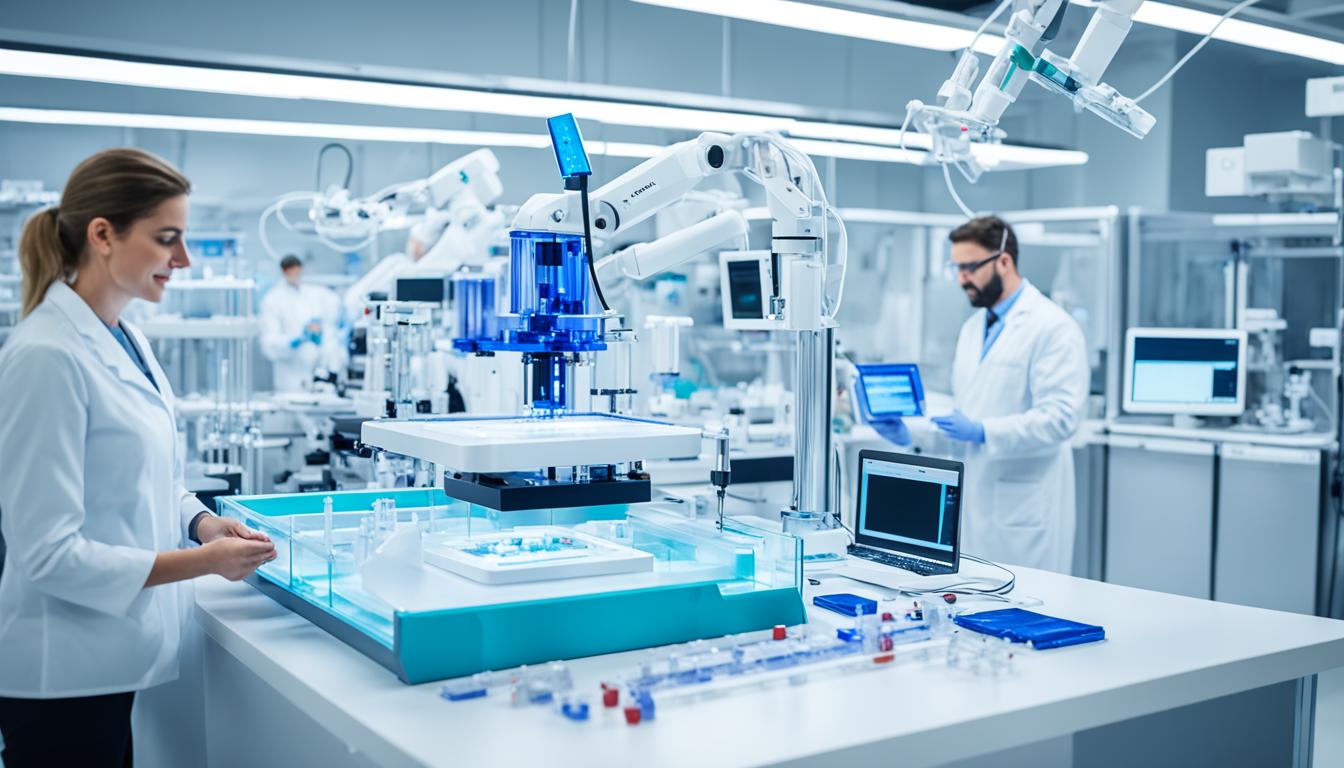Imagine a world where technology makes our lives easier and more exciting. The future is here, and 2024 will bring innovations that change everything we thought was possible.
Artificial intelligence has grown a lot since it started. Now, AI use has jumped by 2.5 times since 20171. Half of all companies use AI for at least one task1. Companies like OpenAI and Eleos Health are changing industries with their AI technology1.
Augmented reality is also making huge strides. Imagine a world where digital and real worlds mix perfectly. This is what augmented reality offers. With products like the Walking Assist Robot and the Solar City car, the future looks bright2.
In bioprinting, healthcare is taking a big leap. Scientists can now print human organs, changing healthcare forever. Imagine not having to wait for organ transplants anymore. With tech like MEDiLight, we’re moving towards personalized medicine2.
Autonomous electric taxis are changing how we travel. Picture cars driving themselves, cutting down on traffic and pollution. Companies like Baracoda are working on smart mirrors that help with mental health2. The future of transport is set to be both smart and green.
The push for cleantech is huge, with $200 billion invested in green tech last year1. This is a 70% jump from the year before1. With green hydrogen and carbon capture tech, we’re tackling climate change1. The US Department of Energy gave $47 million to clean hydrogen projects in 20231.
These are just a few examples of the exciting tech coming our way in 2024. With breakthroughs in many areas, the future is set to amaze us!
Key Takeaways:
- AI adoption has increased significantly, with 50% of organizations implementing AI for at least one business function1.
- Augmented reality is changing the way we interact with the world, with mind-boggling advancements in products like the Walking Assist Robot and the Solar City car2.
- Bioprinting is revolutionizing healthcare with the ability to print functional human organs2.
- Autonomous electric taxis and environmentally friendly transportation are reshaping the future of mobility2.
- Cleantech innovations and investments are on the rise, paving the way for a more sustainable future1.
Artificial Intelligence Revolutionizing Our Lives
Artificial Intelligence (AI) is changing our lives every day, from our phones to our homes. In 2024, AI will change healthcare with new innovations. Companies like Neuralink, led by Elon Musk, aim to make brain-computer interfaces. These will boost our brain power and let us control devices with our thoughts. Other groups, like Kernel, are working on helmets that read minds, offering insights into our brain health and actions. Meta is also pushing AI forward, making it easier to use in apps like Instagram, WhatsApp, and Messenger3.
More and more, AI is being used in different areas. A 2023 IBM survey found 42 percent of big companies use AI, and 40 percent are thinking about it3. Many businesses see AI as a way to automate tasks, with 55 percent using it to make things run smoother3. Since the 1960s and 1970s, AI has been helping in manufacturing, using robotic arms3.
In healthcare, AI is a big deal. It helps analyze big data, which speeds up finding diseases and discovering new drugs3. In finance, AI spots fraud, checks accounts, and helps with loan decisions. Journalists use AI too, with tools that write thousands of news stories a year3. The future of travel looks exciting with self-driving cars and AI travel guides3.
Augmented Reality Enhancing Interactions
Augmented reality (AR) is changing how we see and interact with the world. It uses advanced tech and new apps to make AR a key tool in many areas4. AR is now a big part of retail, education, healthcare, and gaming, making our lives better.
In retail, AR is changing shopping by letting people try on clothes and see how furniture looks before buying4. With AR apps, customers can see how products fit and look on them. This saves time, cuts down on returns, and boosts sales. In the USA, AR is expected to lead to big sales growth by 20244.
AR isn’t just for shopping; it’s also used in education, healthcare, and marketing4. In schools, AR makes learning fun and interactive. Students can explore complex topics, do virtual experiments, and practice medical procedures4. Doctors and nurses use AR for training, remote help, and health awareness campaigns4.
Gaming is a big reason why AR is popular, as it adds new levels to games4. AR makes games more immersive, letting players interact with virtual characters and objects in real life.
| AR Technology Examples | Benefits of AR Technology | Augmented Reality Examples |
|---|---|---|
| Gaming | – Enhanced immersion and interactivity | – Pokemon Go |
| Retail | – Virtual try-ons | – IKEA Place |
| Education | – Interactive learning experiences | – Anatomy 4D |
| Healthcare | – Medical training and remote assistance | – AccuVein |
Smartphones have made mobile AR possible with their high-quality cameras and processors4. These devices are great for making AR apps for many fields. Smart glasses are also becoming popular, especially in industries like manufacturing and logistics4.
AR is also combining with virtual reality (VR) to create mixed-reality experiences in games, stories, and simulations4. This mix lets users interact with virtual things while still seeing the real world.
AR super apps are becoming more common, offering many AR features in one place for better user experience4. These apps have everything from virtual try-ons to interactive games, making things more fun and engaging.
There are many devices leading in AR technology. The RealWear Navigator 520 is a hands-free computer for industrial use with a high-resolution camera and voice control4. The RealWear Navigator Z1 is for dangerous places, with Wi-Fi 6/6E and 5G, keeping users safe and connected4. The Microsoft HoloLens 2 is a mixed-reality headset for professional use in many fields4.
Bioprinting Advancements in Healthcare
Bioprinting is a new way to make artificial tissue and organs using 3D printing. It could solve the problem of not having enough organs for transplants and reduce organ rejection. By using living cells and biomaterials, bioprinting aims to make structures that work like real tissue in the body.
At Tel Aviv University, researchers made a big step forward in bioprinting. They created the world’s first human heart using a patient’s own cells and materials. This shows the huge potential of bioprinting in healthcare and opens doors for future progress.
There’s a big shortage of organs for people with end-stage heart failure. This leads to twenty deaths every day in the U.S. This highlights the urgent need for new bioprinting technologies to solve the organ shortage and help patients.
Nanomedicine combines nanotechnology and medicine to fight diseases. It’s changing healthcare by helping detect diseases early, prevent them, and improve treatments. With about 80 products on the market, nanomedicine is making a big impact.
Nanoparticles are key in nanomedicine. They can carry drugs to specific places in the body, like tumors. This targeted delivery makes treatments more effective and reduces side effects. Nanoparticles also help in medical imaging, making it easier to see inside the body for diagnosis and treatment.
Another exciting area is digital twins. These are virtual copies of real biological systems and patients. They help create personalized treatment plans, practice surgeries, model diseases, and develop drugs. This technology lets doctors give patients more precise care.
In 2024, 37% of mental health visits were online, showing how telepsychiatry is becoming more common. This is because of the growing need for mental health care and the shortage of doctors. Telepsychiatry makes it easier for people to get the help they need.
Artificial intelligence (AI) is changing how we make drugs. It could bring 50 new treatments in the next ten years and save a lot of money. The first AI-designed drug is already being tested in China, showing AI’s big impact on healthcare.
Bioprinting, along with nanomedicine, digital twins, telepsychiatry, and AI in drug development, is changing healthcare. These technologies are leading to more personalized medicine, better treatments, and improved patient outcomes.
| Statistics: | Source: |
|---|---|
| Bioprinting in healthcare is a prominent technology trend in 2024, with advancements showing potential for creating natural-like three-dimensional structures using living cells and bionics. | 5 |
| Researchers at Tel Aviv University have achieved a significant breakthrough by bioprinting the world’s first human heart from a patient’s cells and biomaterials, albeit on a smaller scale. | 5 |
| The shortage of organ availability for individuals suffering from end-stage heart failure leads to an average of twenty deaths daily in the United States, showcasing the need for advancements in bioprinting technologies. | 5 |
| Nanomedicine holds promise in areas such as early disease detection, prevention, and enhancing medical diagnostics and treatments for various illnesses, with approximately 80 marketed products currently spanning different healthcare domains. | 5 |
| Nanoparticles in nanomedicine can encapsulate drugs for targeted delivery to specific sites in the body like tumors, reducing off-target effects and improving therapeutic efficacy. | 5 |
| Nanoparticles also serve as contrast agents in medical imaging techniques to enhance the visualization of tissues and organs, with applications in MRI, CT scans, and fluorescence imaging. | 5 |
| Digital twins, a tech trend in healthcare, leverage real-time data to create virtual simulations of biological systems and individual patients for personalized treatment plans, surgical practice, disease modeling, and drug development. | 5 |
| In 2024, a notable 37% of mental health visits occurred online via telepsychiatry, showcasing a surge in virtual mental health consultations as a critical response to escalating mental health challenges and a shortage of healthcare providers. | 5 |
| Artificial intelligence (AI) is set to revolutionize drug development, potentially introducing 50 new therapies within the next decade and saving billions in development costs annually, with the first drug entirely designed through AI already in clinical trials in China. | 5 |
Autonomous Electric Taxis Redefining Transportation
Technology is changing the way we travel, and it’s exciting. Autonomous electric taxis are leading this change. Zoox is launching its service in 2024, offering a safer and more efficient way to travel. These cars can easily handle city streets after lots of testing6.
Electric cars are a big part of this change. By 2024, they will be a big deal, making up over 40% of new car sales in the US6. They cut down on pollution, making cities cleaner and healthier.
Car-sharing is also key to this shift. Services like Zipcar and Turo let people rent electric cars easily. This means more people can use electric cars without owning them, which is good for the planet6.
Autonomous technology is changing how we see transportation. Companies like Waymo and Uber are working on cars that are safer and more efficient7. These cars use sensors and AI to make smart choices, lowering the chance of accidents. Adding blockchain technology makes these transactions safer and more secure67.
Autonomous electric taxis do more than just make travel easier. They help the planet by cutting down on emissions. Ride-hailing companies are using more electric cars, which is better for the environment and saves money7. Some even let passengers offset their carbon emissions, supporting green practices7.
“The future of transportation is electric, shared, and autonomous.”
Autonomous technology, electric cars, and car-sharing are changing how we move around. The future looks bright with safer, more efficient, and sustainable travel. As technology gets better, we’ll see even more changes that will improve how we get around.

| Key Innovations in Autoclaved Aerated Concrete Production | Reference |
|---|---|
| Waymo’s autonomous vehicles have driven 7.1 million driverless miles, showcasing the rapid progress in autonomous vehicle technology. | 6 |
| Electric vehicles are projected to reach a tipping point in 2024, with more than 40% of new car sales in the US being electric cars. | 6 |
| Car-sharing platforms like Zipcar and Turo offer sustainable transportation options, including electric car rentals. | 6 |
| Autonomous vehicles are being developed by companies like Waymo, Tesla, and Uber to enhance safety and efficiency in the ride-hailing industry. | 7 |
| Ride-hailing companies are investing in technology to enhance driver and passenger safety, including real-time monitoring and emergency response systems. | 7 |
| Electric and hybrid vehicles are being integrated into ride-hailing fleets to promote environmental sustainability and reduce operational costs. | 7 |
Drone Delivery Services Taking Flight
In 2024, the future of package delivery is set to soar with drone delivery services expanding fast.
Amazon leads the industry with its Prime Air drone delivery service. They’ve made over 110,000 drone deliveries in the USA8.
Drone delivery has big benefits. It’s fast, efficient, and reliable, especially in busy cities. Drones can get packages to customers in 30 minutes or less9.
Drone delivery is not just quick and easy for customers. It’s also good for the planet. Drones use much less energy than traditional delivery vans, saving up to 80%9. This helps make delivery more sustainable.
Over three years, over 660,000 commercial drone deliveries have been made8. Walmart and UPS are now using drones too. They’ve made thousands of deliveries safely8.
The FAA sees the potential in drone delivery and has given Amazon more permissions10. Amazon’s drones have a safety system to avoid obstacles10.
The drone delivery market is expected to grow a lot by the end of the decade9. Amazon plans to deliver 500 million packages a year by then109.
Drone Delivery Services in Action
Here’s a chart showing how drone delivery is growing:
| Year | Number of Commercial Drone Deliveries |
|---|---|
| 2021 | 500,000 |
| 2022 | 900,000 |
| 2023 | 1,100,000 |
| 2024 | 1,500,000 |
Table 1: Growth of Commercial Drone Deliveries from 2021-20248
The chart shows drone deliveries are growing fast, by over 80% from 2021-20228.
Drone technology is getting better, and people want fast, green delivery options. Drone delivery is changing how we send packages. It’s set to be a big part of the future of logistics.

3D-Printed Houses Revolutionizing Construction
3D printing is changing the way we build homes. It lets us make houses layer by layer. This new method could change how we think about building homes.
ICON is a leader in this new field. They’ve built over 130 homes in the U.S. and Mexico with their Vulcan printer11. These homes show how strong and reliable 3D-printed houses can be.
ICON’s Phoenix system is a big step forward. It’s a robot that can build tall structures, reaching 27 feet high11. This shows the power of 3D printing in building big projects.
ICON wants to build the world’s first 3D-printed neighborhood11. This big goal shows their ambition and the potential of 3D printing in construction.
ICON is also working with NASA on projects for Mars and the moon11. This shows how 3D printing could help us explore and settle space.
ICON offers Codex, a digital catalog with over 60 home designs ready for printing11. This makes it easy for homeowners to pick and customize their 3D-printed homes.
As 3D printing grows, so will its impact on building homes. New tech and smart devices will make 3D printing even more popular11.
3D printing could make homes cheaper. Some printers can build a small house in just 48 hours12. It could also cut costs by 30%, making homes more affordable for more people12.
3D-printed houses are also good for the planet. They make less waste than traditional building methods12. This helps reduce the construction industry’s environmental impact.
3D printing lets us design and build homes in new ways. Using many 3D printers together can speed up building projects12. This teamwork makes building faster and more efficient.
3D printing is changing construction for the better. It offers affordable, sustainable, and customizable homes. As technology gets better, we’ll see more 3D-printed houses around the world13.

Rise of Electric Cars and Car-Sharing
2024 is shaping up to be a big year for electric vehicles (EVs). They’re becoming more popular because they’re affordable, perform well, and are good for the planet. Experts think EVs will make up over 40% of new car sales in the US14. You can find everything from budget-friendly options like the Kia Niro to high-tech models like the Tesla Cybertruck. Car-sharing services like Zipcar, Turo, and Getaround will also offer more EV rentals, making electric cars easier to get for everyone14.
EVs have many benefits. They cut down on carbon emissions and reduce our need for fossil fuels. They also save money on fuel and upkeep. Plus, EVs are cheaper to run than traditional cars15. With more investment in EV production and charging stations, the future looks bright for electric cars16.
More charging stations are popping up, making EVs more practical. California leads with over 10,000 DC fast chargers, making it easy for EV owners to charge on the go14. This growth in charging spots helps ease range anxiety, making EVs more appealing to people and businesses.
Big car companies are also going electric. They plan to make more or all their cars electric by the end of the decade. Brands like Acura, Alfa Romeo, and Audi are set to release exciting electric models soon16. Apple is even working on its semi-autonomous Apple Car for 2026, which will change the electric car game16.
Electric cars aren’t just for buying. Car-sharing services are adding more EVs to their fleets. This lets people try out electric cars without fully committing. Car-sharing platforms see EVs as a green and affordable way to get around, opening up electric mobility to more people14.
In summary, electric cars and car-sharing are changing how we move around. They offer a sustainable, affordable, and easy way to get around. As the benefits of EVs become clearer, we can expect more people to switch to electric cars14. With the EV market growing and innovation speeding up, we’re in for exciting times in electric transportation.

The Democratization of AI
AI is changing how we work and live fast. It’s no longer just for big companies with lots of money. Now, thanks to open-source AI and easier AI systems, more businesses can use AI to innovate and stay ahead.
OpenAI is leading this change with its work on AI. They’ve created ChatGPT, an AI chatbot that helps users write text. This tool lets developers and companies use AI without needing a lot of tech skills or money.
AI is now used in many business areas like making things automatic, helping with decisions, and talking to customers. Companies big and small are using AI to work better, be more productive, and give customers what they want. This move to AI is helping small and medium-sized businesses grow and innovate.
Groups like governments, companies, nonprofits, and charities are working together to make AI more available. The National Artificial Intelligence Research Resource (NAIRR) pilot in the U.S. is a great example of this17. It brings together 10 federal agencies and 25 private and nonprofit groups to improve AI research and development.
| NAIRR Pilot Focus Areas | Key Partners |
|---|---|
| NAIRR Open | Google, IBM |
| NAIRR Secure | Microsoft, Amazon Web Services |
| NAIRR Software | AI2, Databricks |
| NAIRR Classroom | OpenAI, AMD |
The NAIRR pilot focuses on safe AI, healthcare, and the environment. It started after President Joe Biden’s Executive Order 14110 in October 2023. Researchers can apply for NAIRR resources at nairrpilot.org to use the latest AI for their work.
As AI becomes more open, we must focus on trust and responsible use. NAIRR partners talk about the importance of open research and supporting AI innovation. They highlight the need for collaboration and sharing knowledge.
Building trustworthy AI is key, says Anthropic’s Jack Clark. The NAIRR pilot’s secure AI research is backed by Datavant, which focuses on keeping data safe. DARPA’s Kathleen Fisher sees AI as crucial for national security. Databricks’ Jonathan Frankle believes in the power of open source innovation in AI.

The rise of open-source AI and its adoption is changing industries. It’s an exciting time where AI is making new ways of working possible. This opens up many chances for growth and progress.
Innovation and Investment in Cleantech
The cleantech sector is booming with new ideas and money, making it key for a green future. Over $200 billion has gone into cleantech companies lately, showing its huge potential18.
Investors are really into the 2024 Global Cleantech 100 companies, showing how important cleantech is18. They’re putting money into different areas like Agriculture & Food, Energy & Power, and more18.
More companies in each cleantech area means more competition and new ideas18. This competition leads to big steps forward in clean tech, helping solve big environmental problems.
The drop in deal amounts in Waste & Recycling in 2023 shows how investment trends change18. It also shows support for innovators in this area.
The Inflation Reduction Act is boosting cleantech with more funding and interest18. This act is helping green hydrogen technology become a big deal in clean energy.
Green hydrogen is made from renewable sources and could be huge for clean energy18. It’s great for many areas like transportation and power generation because it doesn’t emit anything.
The cleantech sector is full of chances for investment and growth. Green hydrogen could be a big part of the future for clean energy. As more money goes into different areas and more companies start, the future looks bright for clean tech18.
Cleantech is moving fast, and it’s important to watch the trends and key players19. The Cleantech Group’s 2024 list shows the top private companies leading the way in cleantech19.
A team checks these companies from all over the world, picking ones that are making a big impact19. This list is in its 15th year and shows the best in cleantech innovation and trends19.
The report with the list talks about cleantech investment in 2023 and looks back at 15 years of progress19. It helps investors and experts understand the cleantech world better.
Cleantech innovators got more money for venture and growth in 2023 than other tech areas19. This shows how valuable and impactful clean tech is for the planet and the economy.
Canada’s companies like Carbon Upcycling, Eavor, and Genecis are making a mark in cleantech19. They show Canada’s commitment to green innovation and its role in the global cleantech scene.
The Cleantech Group is hosting a webinar on Global Cleantech Innovation in 202419. It will cover trends, innovations in tough sectors, and new ways to make energy materials and build sustainably.
Summit Nanotech Corporation is a Canadian company leading in greentech20. They’re making lithium extraction for EV batteries better and greener, helping meet global EV needs.
Cleantech Sector Growth and Potential
The greentech sector is expected to grow to $9.5 trillion by 2030, showing its huge potential20. This growth means it will play a big part in solving environmental issues and driving sustainable development.
ZeroAvia is a top company in cleantech, getting 1,500 orders for its hydrogen-electric planes20. This tech is changing the aviation industry to be greener.
Brimstone is working to cut the carbon footprint of building materials by making zero-carbon cement20. They aim to reduce the cement’s big share of greenhouse gases, helping make construction greener.
The green-tech sector is diverse, thanks to big government investments after the Inflation Reduction Act in 202220. These investments show a strong support for sustainable tech and a greener future.
A recent ranking looked at 250 American companies focused on sustainability, based on their environmental impact, financial health, and innovation20. This ranking highlights the growing focus on sustainability and the importance of clean tech in changing industries and reducing harm to the environment.
Innovation is key in tackling emissions in hard-to-abate sectors like aviation20. The industry sees tech as a big part of driving sustainable practices and fighting climate change.
Investment and Innovation Driving Sustainable Future
Innovation and investment in cleantech are big steps towards a sustainable future18. Advances in green hydrogen, carbon capture, and sustainable manufacturing are key to this change.
With more investors and money going into cleantech, the industry is set for more growth and new ideas18. Cleantech is attractive because it’s good for the planet, has market potential, and is financially appealing.
The Cleantech Group’s Global Cleantech 100 list highlights the top companies leading in sustainable innovation19. These companies show how technology can solve big sustainability challenges.
The cleantech sector is expected to grow a lot and companies like ZeroAvia and Brimstone show its potential20. By investing in cleantech and supporting innovations that cut emissions, we can work towards a better world.
We can make a clean and sustainable future by investing in clean tech trends and innovations18. This will help fight climate change and protect the planet for future generations.
| Investment in Cleantech Sectors | Number of Companies Operating |
|---|---|
| Agriculture & Food | XX |
| Energy & Power | XX |
| Materials & Chemicals | XX |
| Resources & Environmental Management | XX |
| Transportation & Logistics | XX |
| Waste & Recycling | XX |

Tech for Early Disease Detection
Technology is changing healthcare by helping detect diseases early, especially in cancer diagnosis. Advanced AI algorithms look at medical data to find early signs of diseases.
AI models are now key in spotting lung cancer risks. They check patients’ records, like scans and genes, to find those at higher risk. This lets doctors act fast and treat patients early.
Startups and researchers are also working on new tech for early detection. Lab-on-a-chip tests can quickly and accurately check biological samples. Smartphone tools are being made so people can check their health at home.
Early detection of diseases is very important. It helps patients get better faster and live longer. For instance, catching cancer early means better treatment options and a higher chance of beating the disease.
AI in early disease detection is getting more common21. New AI models and tech are changing healthcare’s future.
Statistical Data
| Statistical Data | Source |
|---|---|
| In the battery industry, 45% of the EV market share is projected to be occupied by lithium iron phosphate (LFP) batteries in 2029 | Link 1 |
| Over 800 patents related to lithium-ion battery recycling were published in 2023 | Link 1 |
| Researchers are working on developing computational tools and models to predict the environmental impact of new chemicals and processes more accurately within the green chemistry field | Link 1 |
| The bioelectronics market is expanding, with Neuralink receiving FDA approval to begin human trials for its brain-computer interface system in 2023 | Link 1 |
| Space exploration missions like the Artemis program and Chang’e 6 are expected to bring back samples from the moon | Link 1 |
| The use of generative AI in drug discovery is gaining momentum, with breakthroughs such as the AlphaFold protein structure prediction software | Link 1 |
Cybersecurity and Cyber Resilience
The digital threat landscape is getting more complex, with cyberattacks becoming more sophisticated. This is due to the availability of powerful hacking tools and groups backed by nations22. Now, threats include malware, ransomware, and DDoS attacks, making it hard to defend against them22. These threats are not just for big companies but also hit smaller businesses, healthcare, schools, and individuals22.
Nation-state actors play a big role in cyber warfare, making things more complex with their attacks22. There’s also a rise in supply chain attacks, aiming to compromise products and services22. The more IoT devices we have, the more vulnerable we become, with these devices being used for DDoS attacks or network breaches22.
Cyber attackers are now using AI and machine learning to make their attacks more automated and to find weaknesses in systems22. This makes it crucial to use AI in cybersecurity to stay ahead of threats22. But, AI can also be used by cybercriminals for complex attacks22.
New cybersecurity rules and standards are coming out, making it tough for organizations to keep up with threats22. It’s important for companies to have good incident response and resilience plans to prevent and recover from breaches22. The focus is not just on preventing attacks but also on detecting and responding to them to keep business running22.
Working together globally is key to fighting digital threats, with governments and cybersecurity groups joining forces22. The cybersecurity world is always changing, so we all need to work together to stay ahead of cybercriminals and protect our systems and data22.

| Cybersecurity Trends | Cyber Resilience Strategies | AI in Cybersecurity |
|---|---|---|
| The cost of cyber attacks on the global economy is predicted to exceed $10.5 trillion by the end of 202423. | Resilience measures are a strategic priority, recognizing that 100% protection cannot be guaranteed23. | AI-powered solutions are being adopted to enhance cybersecurity defenses and automate cyber defense processes2223. |
| 54% of cyber security professionals believe that the impact of the skills shortage on their organizations has worsened over the past two years23. | Cybersecurity is transitioning from being siloed in IT departments to becoming a strategic priority in boardrooms23. | AI is leveraged by both security teams and malicious actors for sophisticated attacks2223. |
| Gartner predicts that by 2026, 70% of boards will include at least one member with expertise in cybersecurity23. | Clear key performance indicators are essential for managing and measuring cyber risks effectively23. | Zero trust cybersecurity principles are evolving, incorporating continuous AI-powered real-time authentication and activity monitoring23. |
| Businesses in the UK have until April 2024 to comply with minimum security requirements for networked products23. | Communication skills are crucial for increasing cyber resilience and cyber-literacy in the boardroom23. | Generative AI sparks an ethical debate, and organizations must harness it effectively before threat actors exploit it2324. |
| Cyber warfare operations are expected to accompany military conflicts globally in 2024, with common tactics including phishing attacks and DDoS attacks23. | New regulations require more cybersecurity expertise in the boardroom and strategic risk management23. | Small language models are used for tailored and actionable insights to adapt swiftly to evolving threats2324. |
As cyber threats get more complex, it’s vital for organizations to keep up with the latest in cybersecurity. They should use strong resilience strategies and leverage AI in their defenses2223. By using new technologies and strategies, businesses and individuals can lower the risks from cyberattacks and protect their digital assets2223.
The Potential of Quantum Computing
Quantum computing is a big leap in technology. It uses quantum mechanics to do complex calculations faster than ever before. This could change many industries in big ways.
Quantum computers use qubits to work on many problems at once. This could lead to new discoveries in fields like medicine and cryptography. Let’s look at how quantum computing could change things.
Quantum Computing: A Paradigm Shift
As we move into 2024, quantum computing is set to make big strides. In 2022, over 5,000 patents were given out for quantum computing. The U.S. led the way, with 16,000 patents, making up 37% of the world’s total25.
Investments in Quantum Technology (Q.T.) have grown a lot, reaching $42 billion in 2023. China and the U.S. have put in a lot of money, showing they’re serious about quantum tech25.
This big investment means we can expect to see new innovations soon. Experts think the quantum computing market could hit $80 billion by 2035 or 204026. This shows how big the impact of quantum computing could be.
Overcoming Challenges and Pushing Boundaries
Quantum computing is full of promise but also faces challenges. Things like keeping qubits stable, making them bigger, and making them affordable are big hurdles. We need more research to make quantum computing a reality26.
One big challenge is keeping qubits stable. But researchers are working hard to improve this. Their efforts could lead to more progress in quantum computing26.
Quantum computers won’t replace regular computers. They’ll work alongside them. So far, no quantum computer has beaten a supercomputer in real-world tasks. But they can do things that regular computers can’t, like superposition and entanglement27.
Driving Innovation and Collaboration
Combining quantum computing with artificial intelligence (AI) could lead to huge innovations. This mix could make AI even better by speeding up calculations and improving accuracy. It opens up new possibilities in areas like data analysis and optimization26.
Google Quantum AI is at the forefront of this new technology. With experts like Charina Chou and Erik Lucero leading the way, they’re pushing the limits of what’s possible27.
Google believes in the power of quantum computers to solve complex problems. This matches what Nobel Prize winner Richard Feynman envisioned. The speedup in quantum simulation could greatly impact various fields27.
Quantum computing will touch many industries, leading to breakthroughs in areas like medicine and energy. Working together, experts in different fields can unlock the full potential of this technology. This could start a new era of innovation and discovery.

Quantum Computing Statistics
| Quantum Computing Data | Information |
|---|---|
| Nearly 5,000 patents granted in quantum computing in 2022 | Source:25 |
| The United States authorized and issued nearly 16,000 patents in quantum technology by January 2024, representing 37% of the global total | Source:25 |
| Total announced government investment in Quantum Technology (Q.T.) globally was $42 billion in 2023, marking a 26% year-over-year increase | Source:25 |
| China announced $15.3 billion in government spending for Q.T. in 2023, with the U.S. announcing $3.8 billion | Source:25 |
| Total cumulative global quantum startup investment increased by 25% in 2023 to $8.5 billion, spread across 367 startups (a 5% year-over-year increase) | Source:25 |
| 68% of all Q.T. startup investments since 2001 were made in the years 2021 and 2022 | Source:25 |
| The United States and China had the highest numbers of patent applications filed, with 30,099 and 28,593, respectively, as of January 2024 | Source:25 |
| The European Union possessed the highest number and concentration of Quantum Technology talent according to OECD data through 2021, with 113,000 graduates in QT-relevant fields | Source:25 |
| The number of universities offering Quantum Technology programs increased by 8.3% to 195, with those offering master’s degrees in Q.T. increasing by 10% to 55 | Source:25 |
| The quantum computing market is projected to reach around $80 billion by 2035 or 2040 according to McKinsey | Source:26 |
| In 2019, Google achieved quantum supremacy, showcasing the capability of quantum computers to solve complex problems ten times faster than classical computers | Source:26 |
| There are five main qubit technologies identified by McKinsey as crucial for quantum computing development: photonic networks, superconducting circuits, spin qubits, neutral atoms, and trapped ions | Source:26 |
| Quantum computing faces challenges such as decoherence, scalability, physical implementation, cost, and accessibility | Source:26 |
| Error correction methods in quantum computing involve encoding quantum information in several physical qubits for error protection | Source:26 |
| Scalability is a complex process in quantum systems due to challenges related to connecting a large number of qubits for solving more complex problems | Source:26 |
| The field of quantum computing requires expertise in quantum mechanics, computer science, and engineering, creating a shortage of talent that may slow down development and adoption | Source:26 |
| The integration of quantum computing and AI holds significant promise for enhancing AI capabilities by leveraging parallelism and quantum acceleration | Source:26 |
| Google Quantum AI team members: Charina Chou, Director and COO, and Erik Lucero, Lead Quantum Engineering at Google | Source:27 |
| Reference to Nobel Prize winner Richard Feynman in relation to quantum computing | Source:27 |
| Mention of the belief in quantum computers being a powerful tool | Source:27 |
| Reference to unique features of quantum systems like superposition and entanglement | Source:27 |
| Statement that to date, no quantum computer has outperformed a supercomputer on a real-world application | Source:27 |
| Clarification that quantum computers will be complementary to classical computers | Source:27 |
| Explanation of how qubits are created and maintained in quantum computing | Source:27 |
| Reference to the exponential speedup expected in quantum simulation | Source:27 |
| Google Quantum AI team’s commitment to pushing boundaries of quantum computing | Source:27 |
| Aim to harness the technology for advancements in drug discovery and energy optimization | Source:27 |
Conclusion
The future of technology in 2024 is full of new and exciting changes. We’ll see big steps forward in AI, AR, bioprinting, and self-driving cars. These changes will change many industries and bring us into a new era.
One big change is how AI is now available to more people. This has changed the tech world and opened up new possibilities28. Also, we’re learning that losing weight can help prevent heart attacks and strokes28. This shows how technology can help solve big health problems.
Quantum computing is also getting a lot of attention. By 2029, it could make over $2.5 billion in sales worldwide29. This shows how excited people are about this new tech. Plus, using AI to manage data can make decisions 80% more accurate30. This could help businesses innovate and work better.
In 2024, we have a chance to change the world with technology. By combining new tech with creative ideas, we can enter a future with endless possibilities. If we use these advancements wisely, we can make a better, more equal world for everyone.









